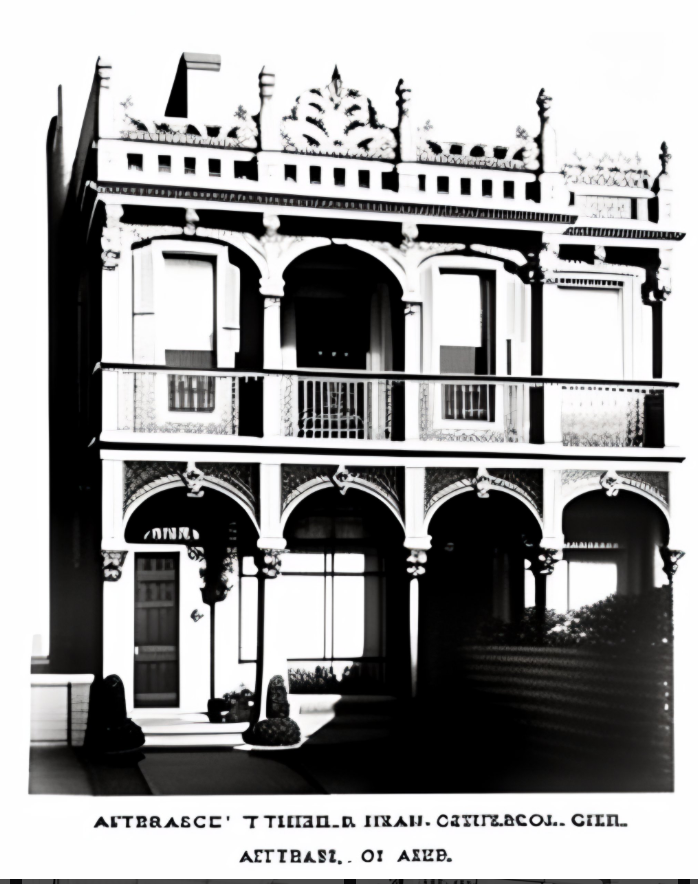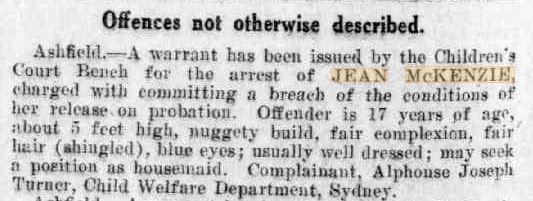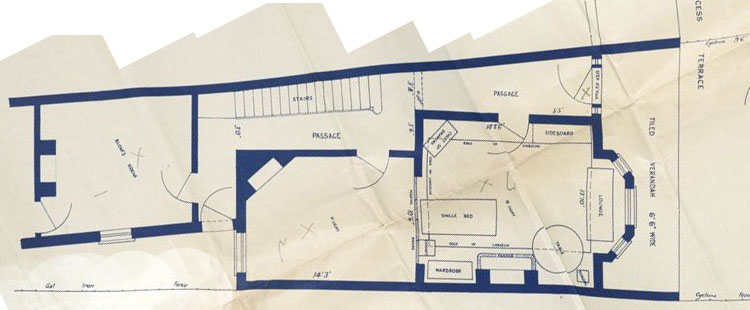Jean MacKenzie inspired this site, I’ve long held an interest in true crime and data science.
Welcome to the world of true crime and data science. Today, we dive into the case of Jean McKenzie, whose brutal murder shook up the working-class and lively suburb of South Melbourne, put the community on edge, and grabbed the locals’ attention.
Jean McKenzie was a 21-year-old woman living in 1 Albert Road, Princes Terrace, South Melbourne, just off St Kilda Road, in 1934. On a Friday evening, June 8th, her housemates, Harry Blom and his wife Myrtle Blom, found her dead. Her murder would be just one of many in Melbourne in roughly 30 years, shocking this typically working-class and industrial suburb just minutes from tranquil beaches, beautiful gardens.
People at the time had strong opinions about what happened in this case, but in my research, I became interested in the Jean McKenzie case when I noticed a number of inconsistencies in news reports over the years. It’s a historical case, so that’s almost a given, but there were also a lot of tantalizing clues that I felt hadn’t been fully explored. I thought that perhaps data science and machine learning might help uncover more clues and resolve some of the inconsistencies.
Let’s start at the beginning. St Kilda Road, South Melbourne, Australia in 1934. Life in Australia in the 1930s was very different from what it is today. For one thing, the population was much smaller. There were only about 7 million people living in Australia in 1930, compared to more than 24 million today. The economy was also very different. Australia was a very rural country in the 1930s, with most people living in small towns or on farms. The main industries were agriculture and mining. There was no such thing as the internet or television, and most people only had radio for entertainment.
Jean’s murder would shake up the working class and lively suburb of South Melbourne, put the community on edge, and grab the locals’ attention. If you’ve never been to Melbourne, it’s an amazing amalgamation of cultures. Melbourne is known for being one of the most livable cities on earth. Much of the time insinuated as ‘the Sporting Capital of the World,’ other than this, it is similarly famous for its graffitied laneways, incredible coffee, and the bayside region. It’s a destination for tourists and a home for artists. At night, there’s always food, drinks, and music, thousands of people travelling down St Kilda Road to Flinders Street Station or the universities.
On the night of June 7, 1934, Jean had a man over to her room in a house in Princess Terrace, St. Kilda Road. St Kilda Road, a major thoroughfare in Melbourne, underwent a significant change in land use from parkland to residential properties in 1875. The western side of the road was alienated and sold for residential purposes, leading to the construction of numerous houses for Melbourne’s wealthy society. This development established St Kilda Road as one of Australia’s fashionable boulevards.
During the 1920s and 1930s, many of the large properties were converted to flats and guest houses, such as the houses at 452 and 478 St Kilda Road. However, in the early 1960s, St Kilda Road underwent another major land-use change when multistoried offices replaced the mansions. One of the first multi-storey developments along this major thoroughfare was the British Petroleum House at the junction of Albert and St Kilda Roads. The contractors for the twenty-two storey building were the prominent firm Costain Hansen and Yuncken.
During the 1880s, in Melbourne’s boom period, speculators took an interest in housing and reduced large crown allotments to long, narrow house sites, building rows of closely-spaced, two-storey houses. Many terrace houses like those in Victoria Avenue were built in suburbs like Fitzroy, Collingwood, Carlton, South Melbourne, Parkville, South Yarra, and East Melbourne. Some terrace houses were built in groups of three, four, or six, while others were built individually and inserted between larger terraces.
These terrace houses had flamboyant fronts with parapets and stuccoed urns, elaborate iron lace to balustrades, and verandas. However, they concealed a street scape behind of back lanes, bluestone cobbles, corrugated iron fences, and unpainted Hawthorn bricks. The terrace house became the characteristic house style of the inner suburbs.
Back to the story…Harry Blom, husband of the landlady, sat talking in the room of Mr Ward, a lodger, and they could hear the two people in Jean’s room arguing. The argument got louder, and then they heard the door open and close. Blom went into the hallway and saw Jean standing at the front door with a man. They were still arguing. The man left, and Jean went back into her room.
The next day, Jean was nowhere to be seen, and her door was still locked. The landlady used a key to open the door and found Jean’s dead body. She had been brutally beaten, and her face was unrecognizable. The detectives began to investigate and found out that Jean had been using different names and moving around a lot to avoid someone. They also found out that she had been in court before for accosting men. They took her fingerprints and found that they matched the fingerprints of a woman with the same description who had been arrested some years earlier.
The community was also buzzing with speculation about who could have committed such a heinous crime. Jean’s murder shook the working-class suburb of South Melbourne, and everyone was on edge. People who lived in the area were afraid that a killer was on the loose, and many were afraid to leave their homes. The local newspapers were filled with sensationalist headlines about the case, and people discussed the details of the murder over dinner tables and in pubs.
As the investigation progressed, the police began to look into potential suspects. They discovered that Jean had a history of using different names and moving around frequently, which made it difficult to track down anyone who might have known her well. However, they did uncover some information that they thought might be useful. For example, they found out that Jean had been in court before for accosting men, which led them to believe that she may have had some kind of dispute with someone on the night of her murder.
The police also interviewed Harry Blom, the man who had heard Jean arguing with a man on the night of her murder. Blom provided a description of the man he had seen, but it was not very detailed. He said that the man was about 5’6″ and wore a dark suit and a dark hat. This was not much to go on, but it was a start.
Despite their efforts, however, the police were unable to make much progress in the case. The murder remained unsolved, and over the years, the investigation faded from the public’s memory.
In 1930’s Melbourne Australia, a murder case went unsolved. The victim was badly beaten, strangled and the body was locked away. At first, it might seem like we have little to go on other than the news reports at the time, but with the help of data science, we can uncover new information about this unsolved murder case and the potential suspects.
One of the tools we can use is the Trove database, which is maintained by the National Library of Australia. Trove is a vast collection of digitized newspapers, articles, photos, and other historical resources that can be searched and analyzed using various data science methods.
To begin the investigation, I started by using some keywords from the articles about the murder case, such as the victim’s name, location, and time frame. Then, I applied these keywords to the Trove database to search for relevant articles and documents.
Using a simple k-means clustering Python script, I used “Jean McKenzie” as a general search term, and with the help of the Trove API, I was able to return article headings, which I grouped into key investigation phases. Using this information, I was able to group the articles into five phases for solved cases and three phases for unsolved crimes. The phases were as follows:
For Solved Cases:
- Initial crime
- Investigation
- Solved
- Trial
- Sentence
For Unsolved Cases:
- Initial crime
- Investigation
- Unsolved
Knowing these phases made it a lot easier to navigate through the articles and databases. I was able to find the murder inquest containing testimony from Mr. & Mrs. Blom, the deaf housemate, police, a friend, and several other witnesses. I was also able to locate a photo of Jean, albeit a badly damaged one.
Using the Stable Diffusion algorithm, I was able to enhance the photo and obtain a clearer image of Jean. I also used art prompts to recreate the scene of the murder, which helped me to better understand the layout of the crime scene and the events that took place.
I also found the inquest into her murder, which contained floor plans of the townhouse where Jean was killed. This was an exciting find, as it gave me a better understanding of the layout of the crime scene.
During my analysis of the data, patterns began to emerge, which led me to suspect a man named William Arthur Scott. I discovered that he had strangled and locked away the body of a woman named Mabel before the murder of Jean. The two cases had many similarities, such as the method of murder and the fact that the bodies were locked away.
This potential suspect’s criminal history and movements around the time of the Melbourne murder raised suspicions. One of the similarities between this suspect and the Melbourne murder was the method of murder. Both victims had been strangled and then locked away, which was a rare and specific type of murder at the time.
The suspect also had a history of violence and criminal activity, which further increased suspicion. He was known to have visited prostitutes, which was a possible connection to the victim in Melbourne, who was also rumored to have been a prostitute. Additionally, the suspect’s divorce hearing indicated that he had a troubled personal life, which could have been a potential motive for murder.
Through the use of data science methods such as clustering, the suspect’s movements and actions leading up to the time of the murder were analyzed. The information gathered from various sources such as Trove newspaper archives was compiled and analyzed to establish a timeline of events, which led to the discovery of the potential suspect.
In my investigation of the unsolved murder case in 1930s Melbourne, I discovered that the killer of Jean McKenzie was likely someone who lived in close proximity to her. Using data science methods to analyze the available data, I was able to identify a triangle of locations around the victim’s house where potential suspects may have lived.
The triangle was formed by three points, each representing a location where a potential suspect lived at some point in time. Using Google Maps, I was able to visualize these locations and plot them on the map.
Interestingly, the first suspect in the case had lived at all three points on the triangle at different times. While this information is highly speculative and should be treated with caution, it is nevertheless a fascinating aspect of the case that could provide valuable insights into the behavior of the killer and their motivations.
This is a great example of how data science can be used to identify patterns and relationships in complex datasets. While the accuracy of these findings may be questionable, they can still provide important clues that can help advance an investigation and bring closure to unsolved cases.

To enhance the photo found of the suspect, stable diffusion was used, which is a popular image enhancement technique in computer vision. Additionally, art prompts were used to recreate the scene of the crime, which helped to visualize the potential sequence of events and provided insight into how the crime could have been committed.
| Scene Description | AI Image Generation Prompt |
|---|---|
| A photo of Jean McKenzie | Generate a realistic 1930’s portrait of a 21-25 year old woman with dark hair sitting on a seawall in st kilda, based on a black and white photograph. |
| The townhouse where the murder took place | Generate a realistic 1930’s 3D image of an australian two of two-story townhouses with a white facades and a wrought-iron fences. The houses has a small front yard with a garden and a narrow pathway leading up to the front door. The windows on the ground floor have white frames and are decorated with potted plants. The second floor has a small balcony with a wrought-iron railing, overlooking the street. |
| The crime scene with evidence markers | Create an image of the crime scene of the Jean McKenzie murder case with evidence markers. The crime scene should include a two-story townhouse with a distinctive front door and balcony. The door and balcony should be visible in the image. Evidence markers should be placed throughout the scene, marking items of interest and potential evidence. The markers should be numbered and visible in the image. Items of interest to be included in the image are a bloodied cord, a discarded cigarette butt, and a broken vase. The overall tone of the image should be somber and evoke a sense of mystery and intrigue. |
| A map of Melbourne with key locations marked | Generate a realistic 1930’s photo of Melbourne, with key locations flinder street station, the shrine of remembrance, the yarra river clearly marked. |
| A photo of the potential suspect from England | Generate a realistic portrait of a man with a thin face, deep-set eyes, and a receding hairline, based on a black and white photograph. |
| The courtroom during the inquest | Generate a realistic 3D rendering of the courtroom, with key figures from the inquest (e.g., the coroner, the detectives, the witnesses) in their respective positions. |
| A recreation of the potential suspect’s suicide attempt | Generate a realistic depiction of the potential suspect lying in a hospital bed with bandages around his throat, based on a description from hospital admission records. |

















Overall, the use of data science techniques in conjunction with various sources of information, including Trove archives, proved to be invaluable in uncovering new information about the unsolved murder case and a potential suspect. The similarities between the case and the potential suspect’s criminal history and movements further strengthened the evidence against him.
To carry out this analysis, I used various data science tools and methods, including web scraping and data cleaning, natural language processing (NLP) for text analysis and clustering, and data visualization to make sense of the results.
I used Python programming language and various Python libraries such as Pandas, NumPy, and Scikit-learn to process the data and run the analysis. I also used Github to store the code and share the results with other researchers and interested parties.
HAS SUICIDED?
Murderer of Melbourne Girl MELBOURNE, Saturday:— In the case of Jean McKenzie, brutally murdered in a house in Princess Terrace, Melbourne, the police, It is claimed, have received authenticated news that the murderer ‘was an American sailor, with a criminal record, who has since committed suicide.
The Age. 28 Oct 1935
I was intrigued by this revelation and wondered why there was so little information available about the American sailor. It’s possible that the police wanted to keep the case quiet in order to avoid a diplomatic incident between Australia and the United States. During the 1930s, the US Navy maintained a presence in Australia, and any scandal involving an American sailor would have been a major blow to the relationship between the two countries.
It’s also possible that the police simply didn’t have enough evidence to pursue the case any further. While it’s frustrating to think that we may never know the full story of what happened to Jean McKenzie, it’s important to remember that even small pieces of information can be valuable in piecing together the larger picture.
In any case, the mystery surrounding the American sailor only serves to underscore the importance of using data science to uncover new information about cold cases. By combing through old records and databases, we can shed new light on cases that were once thought to be unsolvable. And who knows? With further advances in technology and new sources of data becoming available all the time, we may one day be able to solve even the most stubborn of cases.
In conclusion, the unsolved murder case of Jean McKenzie from 1930s Melbourne, Australia was a challenging yet fascinating case to investigate using data science methods. Through keyword searches and data analysis, I was able to uncover previously unknown details about the crime scene, the victim, and potential suspects.
Despite the limited information available, data science allowed me to piece together a timeline of events and connections that may have led to Jean McKenzie’s murder. The use of Stable Diffusion to enhance the available photo, and art prompts to recreate the scene, offered new perspectives and insights into the case.
One of the most intriguing findings was the potential suspect from England, who had committed a similar murder using the same method of strangulation. Although there was no direct evidence linking him to the murder of Jean McKenzie, the similarities in the cases are hard to ignore.
The newspaper article about an American sailor with a criminal record who had committed suicide added an additional layer of intrigue and speculation to the case. It is unclear what the scandal would have been like if this information had been made more public at the time with follow up investigations, and what impact it would have had on the relations between Australia and the American fleet and USA relations.
Overall, this investigation highlights the power of data science in uncovering new information and connections, even in cases that have remained solved for decades. By using a combination of traditional investigative methods and modern data science techniques, we can shed new light on old mysteries and potentially bring closure to those affected by them.


